Interviewed by Ben Tatar
CB: Ryan, tell Critical Bench readers a little about yourself.
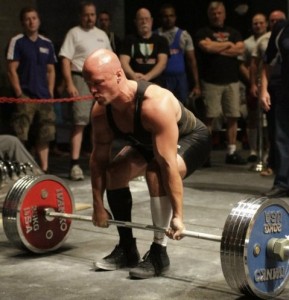 RL: I am Ryan “6 Pack” Lapadat, 33 years old, from Toronto, Ontario. I have been weight lifting since I was 13, and plan on doing it until the day I die.
RL: I am Ryan “6 Pack” Lapadat, 33 years old, from Toronto, Ontario. I have been weight lifting since I was 13, and plan on doing it until the day I die.
When I was a little boy I loved superheroes. I suppose most little boys do, but I genuinely believed I was going to grow up to be a superhero. My friends and I would have discussions on what our super power would be if we could only choose one. Some of my friends chose the power of flying, some the power of speed, but I always chose the power of super strength. In class I would day dream of one day growing up to become a real life superhero who used his super strength to help people.
By the time I became an adult those dreams had all passed. I was conditioned to accept those dreams as merely the imagination of a young boy who did not understand people’s physical limitations. Until some one close to me got sick, suddenly, and passed away. I had just won the National Championships for Powerlifting. The newspapers were interviewing me about my accomplishment when I proclaimed that I wanted to make a difference with my strength.
I went on a city-to-city tour of cancer camps for kids, pulling 26,500 pound school buses 100 feet. The tour made headlines across the country, raised thousands of dollars for sick kids, and more importantly raised hope for those that needed it most. That tour was followed by several large televised events with me flipping over cars, pulling airplanes, lifting bleachers full of people, and rolling up frying pans with my hands. Guinness World Records in strength were shattered. All these events raised money for sick kids. The largest was my appearance on Canada’s Got Talent, seen by 1.5 million viewers. 6 Pack Lapadat quickly became a symbol that anything is possible, any goal was feasible, and no dream was unrealistic if a boy could grow up to be a superhero.
Ryan Lapadat was a normal man. 6 Pack Lapadat became a real life superhero and symbol of hope. I have done many feats of strength in my day, but my greatest feat is making people believe in miracles again.
CB: Ryan, you recently won the World Drug-Free Powerlifting Federation’s (WDFPF) championship with a dramatic come-from-behind victory with the last deadlift of the competition. It was a huge upset win that capped off an incredible year. Tell us about that.
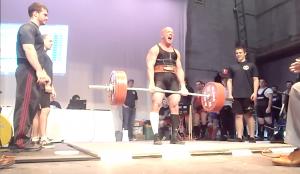 RL: We were lifting in the 90KG unequipped division. It was a true 90KG weight division, with same day weigh-ins and drug testing.
RL: We were lifting in the 90KG unequipped division. It was a true 90KG weight division, with same day weigh-ins and drug testing.
The leads the American and Ukrainian champions had gained in the Squat and Bench Press events were so great I found myself in third place with only one deadlift attempt left in the competition. It could not be more dramatic. Or could it?
I had promised my girlfriend’s dad I would win the World Championships and propose to his daughter. In my mind it was destiny, and I was going to make that final lift to win it all no matter how much weight it was. I wanted a day that our grand kids would recall in generations to come like a fairytale.
I could have lifted a relatively “safe” 585 lbs. for an assured bronze or risk it all for the Gold. Two months prior I failed at a 600 lbs deadlift in competition. I would need to lift more than that if I was to win.
I summoned the strength to lift a personal best 610.5 pounds. It was more than 3 times my body weight. It was a huge come-from-behind, all-or-nothing, attempt that ended up cementing the biggest upset victory of the World Championships. I won the World Championships, but more importantly I got engaged to the love of my life! My fairytale was complete.
And they both lived happily ever after…
CB: What was it like being on Canada’s Got Talent?
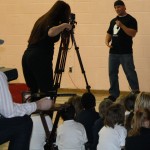 RL: Scary! I am sure every one has seen shows from the ‘Got Talent’ series. Dozens of countries around the world have this TV series, and it is very popular. Canada’s Got Talent booked the Toronto Convention Centre for the Toronto showcase show. As a powerlifter, I am use to performing in front of a crowd. However, this was nothing like a powerlifting meet. The Toronto Convention Centre was packed wall to wall. There were cameras all over the place, even back stage! The show was to be seen by over a million people, and newspapers across the country did write-ups about it.
RL: Scary! I am sure every one has seen shows from the ‘Got Talent’ series. Dozens of countries around the world have this TV series, and it is very popular. Canada’s Got Talent booked the Toronto Convention Centre for the Toronto showcase show. As a powerlifter, I am use to performing in front of a crowd. However, this was nothing like a powerlifting meet. The Toronto Convention Centre was packed wall to wall. There were cameras all over the place, even back stage! The show was to be seen by over a million people, and newspapers across the country did write-ups about it.
No pressure eh?
I was going on the show to perform feats of strength. I knew the show was not designed for my talent, so I had to go big and impress early if I was going to be able to advance. The first round, the audition rounds, I pulled an airplane! My audition tape of me towing the plane is here.
The next round I took it a step further and squatted a bleacher full of cheerleaders and kids! I squatted 6 reps in 30 seconds, and every rep was $200 for Juvenile Diabetes Research Foundation. I got a ‘yes’ from all three judges. I told the judges that I was not in it to win the money, I wanted to make a statement. I promised to give away the $100,000 grand prix if I was to win. The video of that round is here and here’s what was said about me.
“Your heart is as great as your strength” – Martin Short, Canada’s Got Talent judge
“To say it was impressive would be an understatement” – TV Guide
I was eventually cut by the judges before the finals, but made it further than I had expected as a strongman. I was proud to represent powerlifting and strongman.
CB: Tell us about your own TV show on OLN and CityTV.
RL: Canada’s Got Talent was my first introduction to major television. I had been networking in the industry and the opportunity to audition for a show called Get Stuffed came up. The show takes four people from four different competitive backgrounds and pits them in competitions where their backgrounds can’t help them.
Two of the four face off each episode. The four cast members stay the same the whole series, but the face-offs change as they rotate which of the four cast members compete. I was proud to represent powerlifting/strongman on the show. It was a lot of fun.
This was my second nationally televised show, but this time I was a permanent cast member. It helped open even more doors for me. It also helped bring more light on the sport of powerlifting. In Canada, as with America, powerlifting athletes never got that much attention.
CB: Tell Critical Bench readers about the Guinness World Records that you set in weight lifting? I see you have two. Also explain the mental process in achieving them.
RL: I have been performing feats of strength for sick kid’s charities for the past 5 years now. It is a cause close to my heart. On July 16th, 2010, I broke two Guinness World Records in one day. I attempted the 1 hour Squat record, and the 1 hour Deadlift record, both in the same day. It was the hardest thing I ever attempted in my life. I literally trained for 4 months straight, every day, I squatted or deadlifted for four hours straight. When I say I deadlifted or squatted for four hours straight, I mean every 30 seconds I had to lift 5-6 reps. The weight would fluctuate.
It was the most brutal training of my life. One day I did 8 hours of deadlifting, with a set being lifted every 30 seconds. It was to test if I would break mentally.
I almost did get to that the point. You hit a wall, and literally almost break down emotionally in the gym. It is a weird feeling. I was deadlifting at 3am, just to make it even more difficult on myself. I wanted to push myself to the limit in training and prove to myself that I could not be broken mentally. There are bigger and stronger men out there, but I’ll be damned if some one is going to be stronger mentally. I’ll let my body fall to pieces and walk through hell before I quit.
At the end of the day, two Guinness World Records were broken for a local sick kid’s hospital. The kids and parents got a powerful message about mind over matter. We humans have will and pride, and those are tough to break, even when our bodies do.
The video produced by FUSION bodybuilding is here.
CB: Tell us about your experience competing in the World Championships of Powerlifting? How did you celebrate after you won?
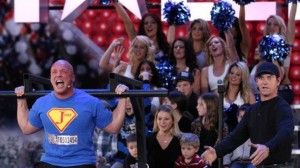 RL: That was the third World Championships I qualified for. It is a lot of hard work to make it that far in Powerlifting, hours and hours of work in the gym.
RL: That was the third World Championships I qualified for. It is a lot of hard work to make it that far in Powerlifting, hours and hours of work in the gym.
The first World Championships I qualified for (82.5 KG, unequipped), I failed to place. I was so far behind the Gold medalist it was as if there was an extra event in his total I hadn’t shown up for, lol.
I didn’t pay it no mind, though. I did my best and stuck to my game plan. I kept at it, and as the years went by I qualified for the Single Lift World Championships in the 90KG weight class (unequipped). That time I was able to place and bring home some medals.
However, it was not the three lift Powerlifting World Championships. I had unfinished business in the 3 lift. This last World Championships was for the three lift World title, and it was my third World Championships. I felt I was ready. I refused to be denied.
As for celebrating, we were in Boston, and went to a restaurant called the Prudential. It is 52 stories up, overlooks the whole city with glass walls, and has a live Jazz band. Classy stuff. We ate like royalty, drank champagne, and lived it up for the night.
CB: What is your advice for others to get strong? Give us ten tips for super human strength!
RL: Funny you ask, I just recently wrote an article giving ten tips to increase strength. I go into more detail than I could here, so allow me to drop the link here and suggest readers give that article a peak. Keep in mind, strength some times comes at the expense of cardio endurance. If your goal is strength, please do read on…
CB: What are your 10 tips for an amazing Squat?
RL: 1) Foot placement for balance can be critical!
Once a lifter is accustomed to the Squat, he (or she) will adjust his foot placement to his specific liking. Often Powerlifters and bodybuilders who have been squatting for years will develop their own squatting style (whether sumo stance, shoulder width, or narrow for bounce at the bottom). For beginners, I would suggest feet shoulder width apart, with the toes pointing out on a 45 degree angle. This will help with balance during the Squat. The feet point out on a 45 degree angle will also force the knees to flare outwards, instead of bow inwards, during the lift. The knees pushing out helps turn on the muscles along the posterior chain (the hamstrings and glutes).
2) Take a full breath of air and hold it!
I know your gym teacher taught you to blow out when you lift weights. Your gym teacher was wrong. Picture a large balloon. We are going to put a small rock on this large balloon. If the ballon is not fully inflated, the weight of the rock will push this balloon forward or backward, and change the form of the ballon. This is what happens when your body is not tight and full of air during the Squat.
When you Squat, it is important to take a full breath of air to inflate that balloon. Now the small rock will sit on the balloon, and not cause the balloon to pitch forward or backward, or loose it’s form.
3) Wrap the bar around your body!
I know, literally speaking, it is impossible to take the barbell, and wrap it around your body. However, when you place the barbell on the bottom of your traps and prepare to squat, I want you to try your hardest to do just that! Clinching the barbell and pulling inward as if attempting to bend the bar around your upper body will tighten your back and shoulders. Again, picture the large balloon. You need the balloon to keep it’s form and stay inflated to balance the small rock on top of it. If you are loose up top, you will pitch forward in your squat and loose form. This will put stress on the lower back.
Taking a full breath of air and clinching the barbell as if to wrap it around you will tighten your upper body up, and engage all the muscles in your core and back. This will greatly improve your balance, and also help strengthen your upper body and core, during the lift.
4) Point your elbows toward the ground!
After you have placed your feet, taken a breath of air, and tightened your upper body, a lifter should point their elbows toward the ground. The elbows should remain pointing towards the ground at all times. Picture your elbows as the steering wheel, and your upper body as the wheels. If your elbows point to the ground, your upper body is being directed to stay upright. If your elbows begin to point backwards on a 45 degree angle (which is the most common placement for those who Squat improperly), then the upper body will be directed to pitch forward. This will in turn put a lot of pressure on the lower back. The pressure on the lower back will then work it’s way down the chain and cause the body to adjust and put more pressure on your knees.
It is important to keep your chest out and facing forward. Have a friend look to see if your elbows are pointing to the ground or backwards on a 45 degree angle when you squat. Often lifters are unaware of the placement of their elbows. Or they begin with the elbows pointing down, but shift them on an angle as they Squat closer to parallel.
5) Look up on a 45 degree angle!
I see people looking at themselves in the mirror all the time when they squat. The best way to keep balance is to remain upright and tight. The body will naturally want to pitch forward with the weight of the barbell on your back as you Squat. Keeping your head tilted on a 45 degree angle upwards, with your eyesight the same, will help keep your upper body upright. Like a person who is beginning to drive, if they look one direction they automatically start steering toward that direction ever so slightly. This is the same with the Squat. Help direct your body in the right direction by controlling your head placement (wrestlers and other athletes already understand the need to keep your head up when lifting).
6) Break at the hips, not the knees!
Once you have completed steps 1-5, you are ready to start lowering into the squat (I know, you never thought there was so much to do with the upper body when Squatting, but now you see why I cringe when people think Squatting is for the legs only). Perhaps lowering into the Squat is not the right wording, as you are not so much lowering as you are sitting backwards.
Attempt to keep your knees in the same place while you break at the hips and push your butt backwards as if you are trying to touch an imaginary wall behind you with it. You keep sitting backward, not sitting straight down, reaching for that wall. The wall is not there, so you end up lowering downwards the further back you reach. This movement, when keeping your upper body tight, will cause you to feel as though your are coiling a spring. A tight upper body is critical to keeping balance. So is flaring your knees outward and not forward or inward.
7) Do not let your knees go past your toes!
A good indication you are not sitting backward, and are in fact sitting straight down too much, is if your knees are drifting past your toes. If that is the case, you are no longer loading up your hamstrings and glutes properly, your upper body is pitching forward too much, and your are putting extra pressure and strain on your lower back and knees.
Just like the elbows, ask a friend to watch you squat and to pay attention if your knees drift over your toes. If they are, a red flag should be set off that your are doing something wrong. Likely you need to tighten your upper body and sit further back in your Squat.
A good way to practice sitting back with the Squat is to grab a bench and to place it directly in the middle of the Squat rack. Your feet will be placed straddling the bench, and you will sit backward onto the bench. You do not sit down onto the bench! You never even touch the bench with our butt. You actually are aiming to touch the bench with your inner thighs. This will make you push your butt out and activate your glutes and hamstrings (which powerlifters call “the seat of power”). You merely touch the bench with your inner thighs as a marker for sitting backward, and rise back up as soon as they do touch. Some times spreading the knees at the bottom of the Squat helps the lifter to achieve the proper depth while not letting their knees drift over their toes. It is at the bottom of the Squat that most lifters have problems keeping their knees back.
8) A flat back is not enough, a proper Squat has an arched back!
Most males Squat with a flat back when they first start out. I have noticed it’s not natural for them to arch their backs when sitting backward into the Squat. This limits the activation of the posterior chain (“The seat of Power”), and ultimately limits the strength and gains the lifter will get out of the lift. It also puts stress on the lower back. Arching the lower back will help the glutes and hamstrings turn on, and keep the upper body tight and flexed. A flat back limits all this by taking the brunt of the lift.
If mastering the arch in the lower back is a problem, I suggest squatting onto a bench as mentioned in step 7. You’ll be able to tell if you’re squatting with an arch in the lower back by what hits the bench. If it’s your butt, arch your lower back more. If it’s your thighs, you’re on point (again, you are not sitting onto the bench, just touching it and then coming back up).
9) Drive upward when in “the hole”!
“The hole” is what powerlifters and bodybuilders call the bottom of the squat. It is important to understand that “the hole” is not a quarter of the way down, or halfway down. “The Hole” is just below parallel. That means you need to squat so the upper part of your leg is parallel to the ground, then the dip just a bit lower so the crook of your hip breaks parallel. That is a full Squat. No less. Any less than that, and you are training partials. Partials are also useful (even lock outs), but should never be mixed up with calling them Squats.
Once in the hole, a lifter is at the most vulnerable part of the lift. They are also at the part of the lift that makes them work the most and gives them the most gains and benefits. That is why it is important to always Squat into the hole, and break parallel with the crook of the hip. Like mentioned before, get a friend to see if you are Squatting low enough (along with if you are keeping your elbows pointing toward the ground, your knees back from your toes, and your head up, chest out).
Once you hit the hole, fire with everything you got to drive upward. Do not pitch forward. Concentrate your force to drive upward. Keeping your chest out, your elbows down, and your head pointing upward will all help with the direction of your drive. If you are looking forward, and your elbows are pointing backward on an angle, than your body is going to be pitched forward slightly. This makes it a lot harder to drive upward. It makes the lift inefficient, and stresses the wrong parts of the lifter.
10) Wash, rinse, and repeat!
Once you have completed the lift, you go through steps 1-10 all over again for every single rep of every single set. That is the rule. That is the unspoken law. The one rep you get lazy on can be the one time you injure yourself (especially when you start to move up in weight).
Getting lazy with your set up will result in diminished results. Properly Squatting will increase muscularity and strength for your whole body, not just your legs! Your arms are flexed pulling on the bar. Your back and shoulder blades are tight and flexed from the pull on the bar. Your chest is out and head up, activating your core and midsection. Your sitting back on the Squat activates the full lower part of your body correctly and efficiently.
When you have mastered the Squat, these 10 steps will not take long to do. In fact, a lifter can set up a squat with all 10 points in a second between every rep once they have them down. However, it is important for a lifter to rehearse these steps with light weight until they have them to memory. To do so, have a friend watch your Squat from the side and to look for the following…
-Is your head up?
-Are your elbows pointing down?
-Did you take a big breath?
-Are your knees drifting over your toes? Are your knees flaring outward like they should in the hole?
-Are you breaking parallel with the crook of your hip?
Thats it for now. Now go Squat. You can thank me later when you see the results!!
CB: What are the 5 biggest mistakes that you see other weight lifters make?
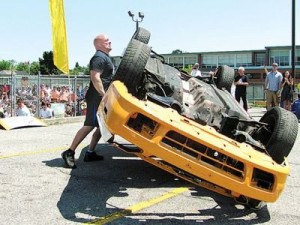 RL: 1)I see people doing ONLY partial squats. Some people are doing quarter squats and thinking they are parallel. Some are doing parallel and thinking they are ass to the grass. There is a major difference in the gains you get from squatting a short range of motion constantly and squatting a full range of motion. Partial squats have a place in your workout routine, but they should not be the only squatting you do.
RL: 1)I see people doing ONLY partial squats. Some people are doing quarter squats and thinking they are parallel. Some are doing parallel and thinking they are ass to the grass. There is a major difference in the gains you get from squatting a short range of motion constantly and squatting a full range of motion. Partial squats have a place in your workout routine, but they should not be the only squatting you do.
2) Not enough free weights! People who say they never see any gains in size and strength are usually the people who stick to the machines. They might get adventurous and try out a smith machine to bench, squat or dead. You will not see proper gains unless you use free weights. Usually, people don’t use free weights because they don’t know proper technique and are intimidated. This is understandable, but ask some one who does know their way around the free weights. Otherwise you will have a low ceiling on your gains.
3) Overuse of wrist straps to keep their grip on the barbell. This will drop your grip strength significantly. Use chalk, or a chalk substitute. You are only as strong as your grip strength. If you need a strap to keep that bar in your hands, than you can’t lift that bar.
4) Getting advice from the wrong places! Be careful where you get your advice from. I see people “training” friends in the gym a lot. Most of the time they are just ordinary gym guys who are taking friends to the gym and showing them how to lift. I know their heart is in the right place, but sometimes they are teaching improper techniques. Being a gym rat does not make you a personal trainer. In most gyms, there will be only a dozen people who know how to Squat and Deadlift properly.
5) People often don’t train a proper routine to hit their whole body evenly. I hear people say every body part gets a full day, so they are hitting their body evenly. Arms, back, chest, shoulders, and legs all get a day of workout.
That’s great, but is your lower body from your waist down 1/5 of your body? No. So why are you training it only 1/5 of your gym days? This is why most people have over developed upper bodies and under developed legs. It is also why most people are amazed at the numbers powerlifters can lift. They don’t realize how strong they could be if they trained properly. Your glutes and hams are your seat of power. Most people are not unlocking that secret to strength. It’s a shame.
CB: What would you like to see change in the iron game?
RL: It is a dream of mine to have Powerlifting in the Olympics. That would pretty much change the game, in all respects, for the best. There would be one federation, with universal equipment rules, drug testing, and mainstream recognition (with media and sponsorships that come with that). There could still be professional federations with multi-gear, and no drug testing. Every sport has professional ranks.
CB: So far in your iron journey list us a) a great moment, b) a crazy moment c) a funny moment and d) a moment that changed you forever.
RL: The greatest moment of my Iron Journey was winning the World Championships of Powerlifting (WDFPF). Being such a big underdog, and coming from behind like that to win it all with the very last deadlift – it was like a movie. I always dreamed of it happening and I always played out a dramatic scene for it, but I never could have dreamed a better story. It was perfect.
The craziest moment was when I tried to pull two planes connected together by a rope, live on National TV. The first plane started to move and then the second plane jack knifed the rope broke, lol, It was a mess.
A moment that changed my life was when I won the National Championships and went on tour to visit Cancer Camps for kids. I pulled 26,500 lbs. school buses. I met some amazing kids and their families and saw things I’ll never forget. It was bitter sweet. I won’t go into detail, but there are some moments I’ll never forget.
CB: What are your future goals?
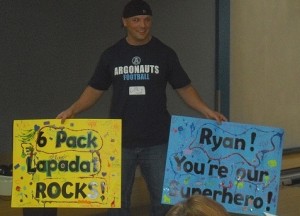 RL: I look forward to defending my World Championship in Scotland next year. I look forward to continuing my television career, and pushing 6 Pack Lapadat, Inc. even further. I have made a lot of strides in the past few years and built my brand. I hope to continue this. I have several projects in the works that will be big for me and for Powerlifting/Strongman.
RL: I look forward to defending my World Championship in Scotland next year. I look forward to continuing my television career, and pushing 6 Pack Lapadat, Inc. even further. I have made a lot of strides in the past few years and built my brand. I hope to continue this. I have several projects in the works that will be big for me and for Powerlifting/Strongman.
I also plan on pulling another plane this year for charity, and doing more charity work for kids now that I am Champ for the year. As long as I can, I want to represent the sport of powerlifting properly, and use my marketing degree to bring media and public attention to the sport.
CB: Do you have any funny or interesting stories that you would like to share?
RL: At my first Nationals I was in a rush and couldn’t find two matching socks. I had to wear one black and one white deadlift sock. I won the Nationals and ever since I wear one black and one white deadlift sock for good luck.
I also took the chalk and drew “superhero muscles” on my lifting suit. I drew in a 6 Pack on my stomach. No one knew who I was, because it was my first Nationals, so people called me 6 Pack.
I won, and the newspapers called me 6 Pack and ever since I have been 6 Pack Lapadat. I have been on two TV shows in Canada, and in both of them as 6 Pack Lapadat. I get booked for appearances, and I am always 6 Pack Lapadat.
Life is funny, you can’t call it. I drew in a fake set of Superhero muscles and now the Canadian press calls me the real life Superhero, 6 Pack Lapadat.
CB: What do you enjoy away from training and competing?
RL: I don’t take much time off training, to be honest. I rarely take a week off straight. That’s a really bid deal for me to do. I love weight lifting that much. But on my down time I like to make music. I have had some of my songs make it onto the radio here in Canada. My journey has been a crazy one, so I’ve got a lot to talk about, lol, Here is a song I wrote while on the road filming my TV show.
CB: How are you going to remember your iron journey?
RL: Sports do not build character, they reveal it.
I’ve seen a lot of people come into the game talking one way, and ending up doing another. Say what you will about me. Say I should have lifted in this fed, in this division, at this time. Say I have gone Hollywood with all the media stuff I am into now, but no one can say I ever did anything to disgrace the sport or myself.
Never will anyone hear about me failing a drug test, or not holding myself appropriately in the media and press. This is the sport of Kings and Queens. My journey in the Iron Game will never come to a close, whether I’m competing or training the next generation, or working to promote the sport behind the scenes.
CB: Thanks for sharing your journey with all of us today. In closing is there anyone who you would like to thank?
RL: I’d like to thank you guys for the interview and all of my supporters for always helping push me forward. I may take to the lifting platform alone, but I always have an army behind me. Any one looking to know more about me and my latest projects can visit www.6packlapadat.com, follow me on twitter at @6packlapadat or find me on Facebook, 6 Pack Lapadat.
Recommended Follow Up Resource:
4 Keys To Savage Strength



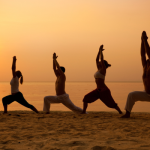
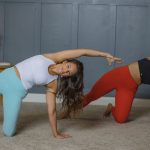



What Ryan, humbly, does not say, is he also encourages others to contribute as he does. He has done so with his two friends, my sons, Kris and Bill. Always supporting them in achieving higher goals for themselves, while helping others. Ryan is an amazing young man.